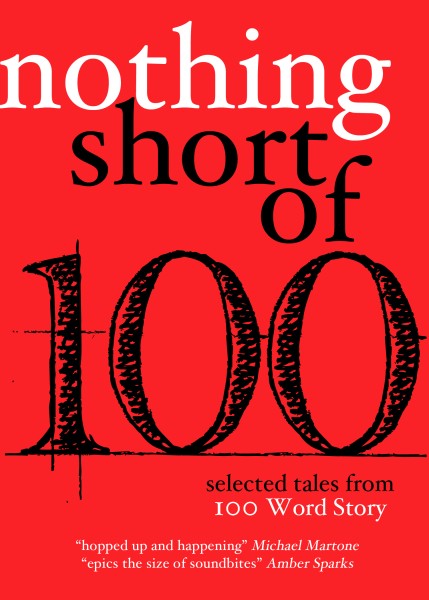
By Cheryl Pappas
In what other form can you find a story about old men floating up in the air, or a narrator’s deep dive into the word “glyph” as a way of coming to grips with the end of a love affair? I found myself ever grateful for the flexibility of the flash form when reading the new anthology Nothing Short of 100 (Outpost19, April 2018). Editors Grant Faulkner, Lynn Mundell, and Beret Olsen have compiled 117 little stories in this slim volume. The “tales,” as the editors call them, have been selected from six years (2012–17) of works published in the online journal 100 Word Story.
The only thing that lets these stories hang together in the space of a book is word count. After that, all bets are off. You’ll find tales of adolescent longing, adolescent terror, marriages that are broken or about to be broken, unquenched desire, magical happenings, and myriad kinds of loss—from the death of a partner, parent, child, a relationship, or innocence.
With such a breadth of topics, the editors at times subtly paired different takes on the same theme, as with the first and the second stories. Tara Masih’s powerful opening story “Ella: Then” tells of a little girl who is obsessed with tiny things. Written in present tense, the descriptions begin innocently enough: “Ella likes things tiny. Tiny toy dishes, tiny dolls. She even wants her dad to be tiny.” But the tone darkens by the third paragraph: “Ella’s father does not shrink to a point of control.” The change to an adult-like voice lets us see the narrator looking back to her childhood self, even though we’re still in the present tense. The next two lines about her father, the last lines of the story, tell us all we need to know: “He smokes, stares, strokes, rolls her around. She goes tiny and red to disappear in cracks.” Masih has pivoted the girl’s desire to change everything into tiny objects so she can control them to wanting to change herself into a tiny object so she can control herself. It is nothing short of masterful.
The very next story, Courtney Watson’s “Hard Time,” takes as its subject Joe, a prisoner who had ordered a miniature antebellum house kit from a hobby magazine. Like Masih’s character, Joe is drawn to tiny objects; the house comes with a “library full of tiny books with real pages,” and he ordered “little doll people” to populate the house. Again, an innocent fascination reveals a lurking depth and sorrow: Joe ruminates that the “little doll people would never, ever in their little doll lives rob the doll bank, armed with a tiny doll gun, shoot two of the doll tellers, and be sent to doll prison.” The last line, which I won’t give away, tenderly hints at a childhood home that was nothing like the dream house. Both stories play with shifts in time and perspective—from that of an adult to that of a child—which is what gives them their resonance.
The beauty of this short form is that it allows so much variation in scope, and the editors of this volume have chosen works that explore the wondrous range of possibilities. Writers can close in on an intimate moment, like in Simon Jimenez’s “Invite Him In, Ask for Help,” in which a man unzips a woman’s dress from the back to discover “her map of pain, the healed tissue so thick it throbbed.” The form also lets you expand outside our space and time, as Amy Lafferty does in her utterly fantastic tale “Diggers.” One summer day, two girls digging deep into the clay find not China, but the place where “the universe sucks its breath in to a single everything” and more. If this were in a longer form, the intensity would be lost. Here, as in poetry, the moment is heightened, and the writing is alert and fresh.
Writers of flash are given the chance to experiment with structure. Several one-paragraph stories are here, but some take on unusual, surprising formats to powerful effect. In “Never Nine,” Rachel Fogarty-Oleson uses a Roman numeral list to outline the stages of life and death of the narrator’s baby in the womb. The first entry is blank (before conception), and item number II reads “Like before: I kept a list of paper cuts and cramps . . .” Right away it’s clear that the woman has been here before and is over feeling any kind of joyful hope in being pregnant. In the middle (V), the author ventures into poetry to describe the narrator’s anxiety about what might lie ahead:
“Your metronome. Gypsophila. Sopravvissuto.”
By using Roman numerals in this diary-like form, Fogarty-Oleson draws on the association of a clock, so metronome makes sense: it refers to the stages of the baby’s growth and serves as the ticking clock of the narrative. Gypsophila is the genus name for baby’s breath. Sopravvissuto means “surviving” in Italian. All these elements together, separated by periods, point to the precariousness of this baby’s life and the narrator’s cautious yet realistic attitude. At the end, the author exploits the beauty and terror of the white space on the page.
Written in a totally different tone, “A Day in the Life of Steve,” by Ashley Chantler, offers a series of 14 social media posts that Steve makes throughout one day. The posts recall the miscellaneous thoughts that we encounter every day on social media: “Hey! Why do other people’s packed lunches always look better than your own?” and “Who invented UHT milk? Genius” are just some examples. Taken out of the online context, the posts ring hollow, and evoke the feeling of watching a stand-up comic talking to a dark, empty room. The editors call the story in their introduction a “glimpse into stream-of-consciousness to hilarious effect,” but I found it more on the tragic end of comic. I hope to see more writers explore the depths of this chasm between our online life and our inner world, because there’s a lot to mine.
This book is as good a primer as any for writers looking to achieve nuance and power in such a short space. Sherrie Flick’s mots justes “flaccidly” and “aquiver” had me sitting up at attention; I loved how the phrase “Drive fast, take chances!,” the title of Tom Hazuka’s story, ratchets up the tension in this tale about a man catching his friend and his ex-girlfriend cozy up on the porch as he leaves their party; and I admire without end the last line in Jean-Luc Bouchard’s “Thicker than Water.” Though short, the stories in this collection will resonate long after you close the book. If you’re like me, you won’t rest until you read them again.
 Cheryl Pappas is a writer from Boston. Her fiction and essays have appeared in The Bitter Oleander, Cleaver Magazine, Ploughshares blog, SmokeLong Quarterly, Tin House online, and Essay Daily. She holds an MFA in Fiction from Bennington Writing Seminars. She is currently working on a collection of fables. Her website is cherylpappas.net and you can follow her on Twitter at @fabulistpappas.
Cheryl Pappas is a writer from Boston. Her fiction and essays have appeared in The Bitter Oleander, Cleaver Magazine, Ploughshares blog, SmokeLong Quarterly, Tin House online, and Essay Daily. She holds an MFA in Fiction from Bennington Writing Seminars. She is currently working on a collection of fables. Her website is cherylpappas.net and you can follow her on Twitter at @fabulistpappas.

